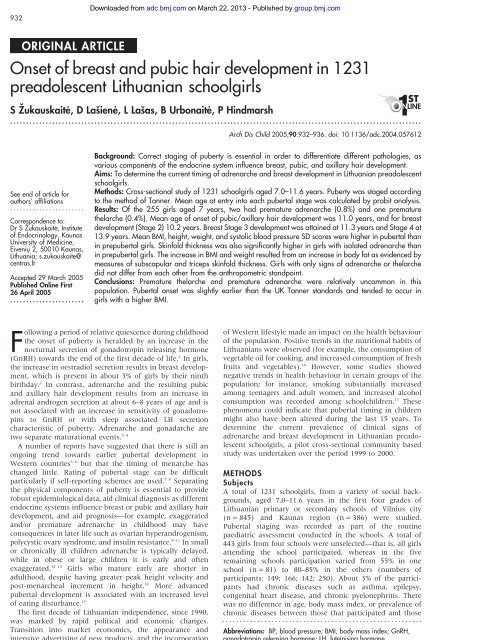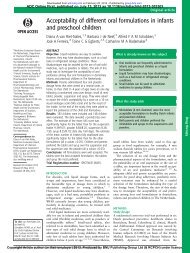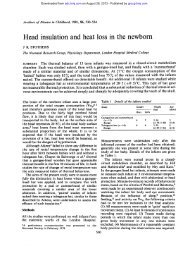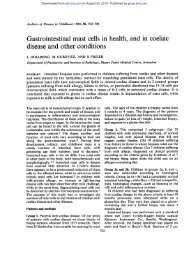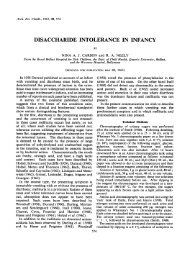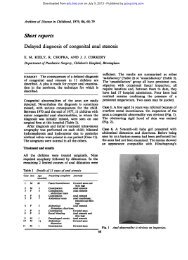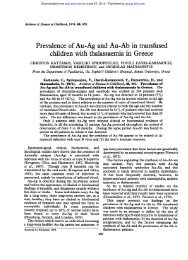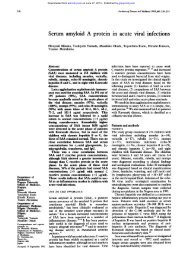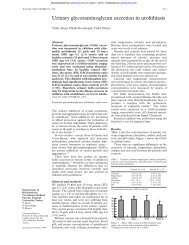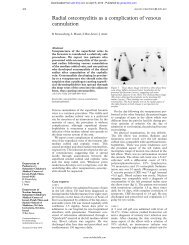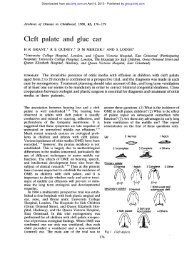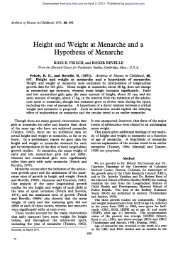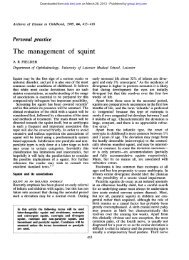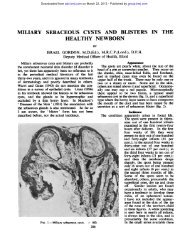Onset of breast and pubic hair development in - Archives of Disease ...
Onset of breast and pubic hair development in - Archives of Disease ...
Onset of breast and pubic hair development in - Archives of Disease ...
Create successful ePaper yourself
Turn your PDF publications into a flip-book with our unique Google optimized e-Paper software.
932<br />
ORIGINAL ARTICLE<br />
<strong>Onset</strong> <strong>of</strong> <strong>breast</strong> <strong>and</strong> <strong>pubic</strong> <strong>hair</strong> <strong>development</strong> <strong>in</strong> 1231<br />
preadolescent Lithuanian schoolgirls<br />
SZ ˇ ukauskaite˙, D Lasˇiene˙, L Lasˇas, B Urbonaite˙, P H<strong>in</strong>dmarsh<br />
...............................................................................................................................<br />
See end <strong>of</strong> article for<br />
authors’ affiliations<br />
.......................<br />
Correspondence to:<br />
Dr S Z ˇ ukauskaite˙, Institute<br />
<strong>of</strong> Endocr<strong>in</strong>ology, Kaunas<br />
University <strong>of</strong> Medic<strong>in</strong>e,<br />
Eiveniu˛ 2, 50010 Kaunas,<br />
Lithuania; s.zukauskaite@<br />
centras.lt<br />
Accepted 29 March 2005<br />
Published Onl<strong>in</strong>e First<br />
26 April 2005<br />
.......................<br />
F ollow<strong>in</strong>g<br />
Arch Dis Child 2005;90:932–936. doi: 10.1136/adc.2004.057612<br />
Background: Correct stag<strong>in</strong>g <strong>of</strong> puberty is essential <strong>in</strong> order to differentiate different pathologies, as<br />
various components <strong>of</strong> the endocr<strong>in</strong>e system <strong>in</strong>fluence <strong>breast</strong>, <strong>pubic</strong>, <strong>and</strong> axillary <strong>hair</strong> <strong>development</strong>.<br />
Aims: To determ<strong>in</strong>e the current tim<strong>in</strong>g <strong>of</strong> adrenarche <strong>and</strong> <strong>breast</strong> <strong>development</strong> <strong>in</strong> Lithuanian preadolescent<br />
schoolgirls.<br />
Methods: Cross-sectional study <strong>of</strong> 1231 schoolgirls aged 7.0–11.6 years. Puberty was staged accord<strong>in</strong>g<br />
to the method <strong>of</strong> Tanner. Mean age at entry <strong>in</strong>to each pubertal stage was calculated by probit analysis.<br />
Results: Of the 255 girls aged 7 years, two had premature adrenarche (0.8%) <strong>and</strong> one premature<br />
thelarche (0.4%). Mean age <strong>of</strong> onset <strong>of</strong> <strong>pubic</strong>/axillary <strong>hair</strong> <strong>development</strong> was 11.0 years, <strong>and</strong> for <strong>breast</strong><br />
<strong>development</strong> (Stage 2) 10.2 years. Breast Stage 3 <strong>development</strong> was atta<strong>in</strong>ed at 11.3 years <strong>and</strong> Stage 4 at<br />
13.9 years. Mean BMI, height, weight, <strong>and</strong> systolic blood pressure SD scores were higher <strong>in</strong> pubertal than<br />
<strong>in</strong> prepubertal girls. Sk<strong>in</strong>fold thickness was also significantly higher <strong>in</strong> girls with isolated adrenarche than<br />
<strong>in</strong> prepubertal girls. The <strong>in</strong>crease <strong>in</strong> BMI <strong>and</strong> weight resulted from an <strong>in</strong>crease <strong>in</strong> body fat as evidenced by<br />
measures <strong>of</strong> subscapular <strong>and</strong> triceps sk<strong>in</strong>fold thickness. Girls with only signs <strong>of</strong> adrenarche or thelarche<br />
did not differ from each other from the anthropometric st<strong>and</strong>po<strong>in</strong>t.<br />
Conclusions: Premature thelarche <strong>and</strong> premature adrenarche were relatively uncommon <strong>in</strong> this<br />
population. Pubertal onset was slightly earlier than the UK Tanner st<strong>and</strong>ards <strong>and</strong> tended to occur <strong>in</strong><br />
girls with a higher BMI.<br />
a period <strong>of</strong> relative quiescence dur<strong>in</strong>g childhood<br />
the onset <strong>of</strong> puberty is heralded by an <strong>in</strong>crease <strong>in</strong> the<br />
nocturnal secretion <strong>of</strong> gonadotrop<strong>in</strong> releas<strong>in</strong>g hormone<br />
(GnRH) towards the end <strong>of</strong> the first decade <strong>of</strong> life. 1 In girls,<br />
the <strong>in</strong>crease <strong>in</strong> oestradiol secretion results <strong>in</strong> <strong>breast</strong> <strong>development</strong>,<br />
which is present <strong>in</strong> about 3% <strong>of</strong> girls by their n<strong>in</strong>th<br />
birthday. 2 In contrast, adrenarche <strong>and</strong> the result<strong>in</strong>g <strong>pubic</strong><br />
<strong>and</strong> axillary <strong>hair</strong> <strong>development</strong> results from an <strong>in</strong>crease <strong>in</strong><br />
adrenal <strong>and</strong>rogen secretion at about 6–8 years <strong>of</strong> age <strong>and</strong> is<br />
not associated with an <strong>in</strong>crease <strong>in</strong> sensitivity <strong>of</strong> gonadotrop<strong>in</strong>s<br />
to GnRH or with sleep associated LH secretion<br />
characteristic <strong>of</strong> puberty. Adrenarche <strong>and</strong> gonadarche are<br />
two separate maturational events.<br />
A number <strong>of</strong> reports have suggested that there is still an<br />
ongo<strong>in</strong>g trend towards earlier pubertal <strong>development</strong> <strong>in</strong><br />
Western countries 5 6 but that the tim<strong>in</strong>g <strong>of</strong> menarche has<br />
changed little. Rat<strong>in</strong>g <strong>of</strong> pubertal stage can be difficult<br />
particularly if self-report<strong>in</strong>g schemes are used. 7 8 Separat<strong>in</strong>g<br />
the physical components <strong>of</strong> puberty is essential to provide<br />
robust epidemiological data, aid cl<strong>in</strong>ical diagnosis as different<br />
endocr<strong>in</strong>e systems <strong>in</strong>fluence <strong>breast</strong> or <strong>pubic</strong> <strong>and</strong> axillary <strong>hair</strong><br />
<strong>development</strong>, <strong>and</strong> aid prognosis—for example, exaggerated<br />
<strong>and</strong>/or premature adrenarche <strong>in</strong> childhood may have<br />
consequences <strong>in</strong> later life such as ovarian hyper<strong>and</strong>rogenism,<br />
polycystic ovary syndrome, <strong>and</strong> <strong>in</strong>sul<strong>in</strong> resistance. 9–11 In small<br />
or chronically ill children adrenarche is typically delayed,<br />
while <strong>in</strong> obese or large children it is early <strong>and</strong> <strong>of</strong>ten<br />
exaggerated. 12 13 Girls who mature early are shorter <strong>in</strong><br />
adulthood, despite hav<strong>in</strong>g greater peak height velocity <strong>and</strong><br />
post-menarcheal <strong>in</strong>crement <strong>in</strong> height. 14 More advanced<br />
pubertal <strong>development</strong> is associated with an <strong>in</strong>creased level<br />
<strong>of</strong> eat<strong>in</strong>g disturbance. 15<br />
The first decade <strong>of</strong> Lithuanian <strong>in</strong>dependence, s<strong>in</strong>ce 1990,<br />
was marked by rapid political <strong>and</strong> economic changes.<br />
Transition <strong>in</strong>to market economics, the appearance <strong>and</strong><br />
<strong>in</strong>tensive advertis<strong>in</strong>g <strong>of</strong> new products, <strong>and</strong> the <strong>in</strong>corporation<br />
www.archdischild.com<br />
Downloaded from<br />
adc.bmj.com on March 22, 2013 - Published by group.bmj.com<br />
3 4<br />
<strong>of</strong> Western lifestyle made an impact on the health behaviour<br />
<strong>of</strong> the population. Positive trends <strong>in</strong> the nutritional habits <strong>of</strong><br />
Lithuanians were observed (for example, the consumption <strong>of</strong><br />
vegetable oil for cook<strong>in</strong>g, <strong>and</strong> <strong>in</strong>creased consumption <strong>of</strong> fresh<br />
fruits <strong>and</strong> vegetables). 16 However, some studies showed<br />
negative trends <strong>in</strong> health behaviour <strong>in</strong> certa<strong>in</strong> groups <strong>of</strong> the<br />
population; for <strong>in</strong>stance, smok<strong>in</strong>g substantially <strong>in</strong>creased<br />
among teenagers <strong>and</strong> adult women, <strong>and</strong> <strong>in</strong>creased alcohol<br />
consumption was recorded among schoolchildren. 17 These<br />
phenomena could <strong>in</strong>dicate that pubertal tim<strong>in</strong>g <strong>in</strong> children<br />
might also have been altered dur<strong>in</strong>g the last 15 years. To<br />
determ<strong>in</strong>e the current prevalence <strong>of</strong> cl<strong>in</strong>ical signs <strong>of</strong><br />
adrenarche <strong>and</strong> <strong>breast</strong> <strong>development</strong> <strong>in</strong> Lithuanian preadolescent<br />
schoolgirls, a pilot cross-sectional community based<br />
study was undertaken over the period 1999 to 2000.<br />
METHODS<br />
Subjects<br />
A total <strong>of</strong> 1231 schoolgirls, from a variety <strong>of</strong> social backgrounds,<br />
aged 7.0–11.6 years <strong>in</strong> the first four grades <strong>of</strong><br />
Lithuanian primary or secondary schools <strong>of</strong> Vilnius city<br />
(n = 845) <strong>and</strong> Kaunas region (n = 386) were studied.<br />
Pubertal stag<strong>in</strong>g was recorded as part <strong>of</strong> the rout<strong>in</strong>e<br />
paediatric assessment conducted <strong>in</strong> the schools. A total <strong>of</strong><br />
443 girls from four schools were unselected—that is, all girls<br />
attend<strong>in</strong>g the school participated, whereas <strong>in</strong> the five<br />
rema<strong>in</strong><strong>in</strong>g schools participation varied from 55% <strong>in</strong> one<br />
school (n = 81) to 80–85% <strong>in</strong> the others (numbers <strong>of</strong><br />
participants: 149; 166; 142; 250). About 3% <strong>of</strong> the participants<br />
had chronic diseases such as asthma, epilepsy,<br />
congenital heart disease, <strong>and</strong> chronic pyelonephritis. There<br />
was no difference <strong>in</strong> age, body mass <strong>in</strong>dex, or prevalence <strong>of</strong><br />
chronic diseases between those that participated <strong>and</strong> those<br />
Abbreviations: BP, blood pressure; BMI, body mass <strong>in</strong>dex; GnRH,<br />
gonadotrop<strong>in</strong> releas<strong>in</strong>g hormone; LH, lute<strong>in</strong>is<strong>in</strong>g hormone
Downloaded from<br />
adc.bmj.com on March 22, 2013 - Published by group.bmj.com<br />
Puberty <strong>of</strong> Lithuanian girls 933<br />
Table 1 Anthropometric details <strong>of</strong> girls <strong>in</strong> different age groups<br />
Subscapular Triceps sk<strong>in</strong>fold Systolic blood<br />
Body mass <strong>in</strong>dex<br />
sk<strong>in</strong>fold thickness thickness<br />
pressure Diastolic blood pressure Prepubertal Adrenarche Thelarche ‘‘Pubertal’’<br />
(kg/m Waist:hip ratio<br />
2 ) (mm) (mm) (mm Hg) (mm Hg) n (%) n (%) n (%) n (%)<br />
Age (y) n<br />
7.0–7.9 255 15.7 (15.4–15.9) 0.82 (0.81–0.82) 6.4 (6.1–6.8) 11.4 (10.9–11.9) 105.8 (104.3–107.3) 67.6 (66.4–68.8) 252 (98.8) 2 (0.8) 1 (0.4) –<br />
8.0–8.9 295 16.0 (15.8–16.3) 0.81 (0.81–0.81) 7.2 (6.7–7.7) 12.4 (11.9–12.9) 108.0 (106.7–109.3) 69.0 (67.9–70.1) 262 (88.8) 14 (4.7) 16 (5.4) 3 (1.0)<br />
9.0–9.9 302 16.5 (16.3–16.8) 0.80 (0.80–0.81) 7.5 (7.1–8.0) 12.9 (12.4–13.4) 111.0 (109.8–112.3) 70.4 (69.4–71.4) 197 (65.2) 25 (8.3) 59 (19.5) 21 (7.0)<br />
10.0–10.9 299 17.0 (16.6–17.3) 0.79 (0.79–0.80) 8.6 (7.9–9.2) 13.8 (13.1–14.5) 113.4 (112.0–114.9) 71.6 (70.7–72.6) 95 (31.8) 27 (9.0) 102 (34.1) 75 (25.1)<br />
11.0–11.6 80 16.6 (16.1–17.2) 0.79 (0.78–0.80) 7.9 (6.9–8.8) 13.0 (11.9–14.2) 117.6 (115.1–120.0) 74.2 (72.1–76.2) 10 (12.5) 3 (3.8) 27 (33.8) 40 (50.0)<br />
Total: 1231 16.3 (16.2–16.5) 0.80 (0.80–0.81) 7.5 (7.3–7.7) 12.7 (12.4–13.0) 110.2 (109.5–110.9) 70.0 (69.5–70.5) 816 (66.3) 71 (5.8) 205 (16.7) 139 (11.3)<br />
Anthropometric data are shown as mean (95% CI).<br />
that did not. Informed consent to participate was obta<strong>in</strong>ed<br />
from the parents <strong>and</strong> assent from the children where<br />
appropriate. The study was approved by the Ethics<br />
Committee for Biomedical Research <strong>of</strong> Kaunas region.<br />
Pubertal <strong>development</strong> was staged by the same paediatric<br />
endocr<strong>in</strong>ologist (SZ) us<strong>in</strong>g the method <strong>of</strong> Tanner. 18 Mean age<br />
<strong>of</strong> onset <strong>of</strong> adrenarche <strong>and</strong> thelarche were compared with<br />
previous Lithuanian data, collected between 1984 <strong>and</strong> 1985. 19<br />
Premature adrenarche <strong>and</strong> premature thelarche were considered<br />
when there were signs <strong>of</strong> <strong>pubic</strong>/axillary <strong>hair</strong> <strong>development</strong><br />
<strong>and</strong> <strong>breast</strong> <strong>development</strong> respectively present before<br />
the age <strong>of</strong> 8 years. All girls were checked for presence <strong>of</strong><br />
hirsutism by <strong>in</strong>spection. Height (cm) <strong>and</strong> weight (kg) were<br />
recorded at exam<strong>in</strong>ation <strong>and</strong> body mass <strong>in</strong>dex (kg/m 2 )<br />
derived. Sk<strong>in</strong>fold thickness (mm) was measured at subscapular<br />
<strong>and</strong> triceps sites us<strong>in</strong>g Holta<strong>in</strong> calliper (LTD,<br />
Crymych, UK). Hip <strong>and</strong> waist circumferences (cm) were<br />
recorded <strong>and</strong> the waist-to-hip ratio calculated. Daytime blood<br />
pressure (BP) was measured us<strong>in</strong>g aneroid sphygmomanometer<br />
with appropriate cuff sizes. For some analyses<br />
participants were grouped by one year age <strong>in</strong>tervals.<br />
Statistical analysis<br />
Estimates for mean age at entry <strong>in</strong>to a pubertal stage were<br />
calculated by probit analysis from the proportions <strong>of</strong> girls<br />
with the characteristic at different ages. Probit analysis is the<br />
procedure that measures the relation between the strength <strong>of</strong><br />
a stimulus <strong>and</strong> the proportion <strong>of</strong> cases exhibit<strong>in</strong>g a certa<strong>in</strong><br />
response to the stimulus. It is useful for situations where<br />
there is a dichotomous output that is thought to be<br />
<strong>in</strong>fluenced or caused by levels <strong>of</strong> some <strong>in</strong>dependent<br />
variable(s). Probit regression is an alternative log-l<strong>in</strong>ear<br />
approach to h<strong>and</strong>l<strong>in</strong>g categorical dependent variables.<br />
Anthropometric data were expressed as means with 95%<br />
CI. BMI, height, weight, <strong>and</strong> sk<strong>in</strong>fold thickness at triceps <strong>and</strong><br />
subscapular sites were expressed as st<strong>and</strong>ard deviation scores<br />
(SDS) us<strong>in</strong>g 1996 Growth Reference Data <strong>of</strong> Dutch children 20<br />
to allow comparisons at different ages. Blood pressure was<br />
also expressed as an SDS us<strong>in</strong>g data from the Second Task<br />
Force on Blood Pressure Control <strong>in</strong> Children. 21 Cross-sectional<br />
associations between age <strong>and</strong> different anthropometric<br />
characteristics, <strong>and</strong> their SDS, as well as between waist-tohip<br />
ratio <strong>and</strong> other variables, were assessed by Pearson’s<br />
correlation coefficient. Mean BMI SDS, sk<strong>in</strong>fold thickness<br />
SDS, <strong>and</strong> waist-to-hip ratio between <strong>in</strong>dependent groups <strong>of</strong><br />
different pubertal status were compared by multivariate<br />
analysis <strong>of</strong> variance (ANOVA), corrected by Scheffé’s test for<br />
multiple comparisons. Statistical significance was considered<br />
when p , 0.05.<br />
RESULTS<br />
General<br />
Anthropometric <strong>and</strong> pubertal stag<strong>in</strong>g data are shown <strong>in</strong><br />
table 1. Girls with <strong>pubic</strong> (Stages P2–P4) <strong>and</strong>/or axillary <strong>hair</strong><br />
alone were denoted as ‘‘adrenarche’’, signs <strong>of</strong> <strong>breast</strong><br />
<strong>development</strong> (Stages B2–B4) alone as ‘‘thelarche’’, <strong>and</strong> those<br />
with a comb<strong>in</strong>ation <strong>of</strong> the two characteristics ‘‘pubertal’’. As<br />
expected, mean age differed between each <strong>of</strong> the group’s<br />
puberty (p , 0.005). Anthropometric data accord<strong>in</strong>g to<br />
pubertal status are shown <strong>in</strong> table 2.<br />
Tim<strong>in</strong>g <strong>of</strong> secondary sexual characteristics<br />
Figure 1 shows the proportion <strong>of</strong> girls with different pubertal<br />
status presented <strong>in</strong> yearly <strong>in</strong>crements <strong>of</strong> age. Mean age for<br />
onset <strong>of</strong> <strong>breast</strong> <strong>development</strong> was 10.2 (95% CI 10.1 to 10.3)<br />
years, atta<strong>in</strong>ment <strong>of</strong> Breast Stage 3 was at 11.3 (95% CI 11.1<br />
to 11.6) years, <strong>and</strong> Breast Stage 4 was estimated to beg<strong>in</strong> at<br />
13.9 (95% CI 12.6 to 18.5) years.<br />
www.archdischild.com
934 Z ˇ ukauskaite˙, Lasˇiene˙, Lasˇas, et al<br />
Table 2 Anthropometric details <strong>of</strong> girls with different pubertal characteristics<br />
www.archdischild.com<br />
Diastolic blood<br />
pressure SDS<br />
Systolic blood<br />
pressure SDS<br />
Subscapular<br />
sk<strong>in</strong>fold SDS Triceps sk<strong>in</strong>fold SDS<br />
Body mass<br />
<strong>in</strong>dex SDS Waist:hip ratioÀ<br />
Age (y) Height SDS Weight SDS<br />
Downloaded from<br />
adc.bmj.com on March 22, 2013 - Published by group.bmj.com<br />
Prepubertal 8.6 (8.59 to 8.73) 20.61 (20.68 to 20.55) 20.27 (20.31 to 20.19) 0.03 (20.06 to 0.12) 0.81 (0.81 to 0.81) 0.13 (0.01 to 0.25) 0.76 (0.65 to 0.87) 0.90 (0.82 to 0.97) 0.75 (0.65 to 0.81)<br />
Adrenarche 9.6 (9.47 to 9.87)** 20.51 (20.77 to 20.25) 0.09 (20.25 to 0.43) 0.45 (0.08 to 0.82) 0.81 (0.79 to 0.82) 0.99 (0.35 to 1.63)* 1.48 (1.01 to 1.96)** 1.01 (0.76 to 1.27) 0.93 (0.70 to 1.17)<br />
Thelarche 10.1 (10.03 to 10.24)** 20.47 (20.59 to 20.34) 20.17 (20.33 to 0.01) 0.04 (20.15 to 0.23) 0.79 (0.79 to 0.80)** 0.51 (0.24 to 0.77) 1.16 (0.94 to 1.37)* 1.13 (0.97 to 1.28) 0.87 (0.75 to 1.00)<br />
‘‘Pubertal’’ 10.5 (10.45 to 10.65)** 20.15 (20.29 to 20.01)** 0.30 (0.05 to 0.55)** 0.39 (0.11 to 0.67)* 0.79 (0.79 to 0.80)** 0.84 (0.47 to 1.22)** 1.27 (0.95 to 1.58)* 1.36 (1.20 to 1.59)** 0.95 (0.80 to 1.11)<br />
Data shown as mean (95% CI). Significant differences compar<strong>in</strong>g groups <strong>of</strong> puberty versus ‘‘prepubertal’’ group are <strong>in</strong>dicated.<br />
*The mean difference is significant at the 0.05 level.<br />
**The mean difference is significant at the 0.005 level.<br />
ÀMean values were tested adjusted for one year age <strong>in</strong>tervals (two way ANOVA).<br />
Pubic <strong>hair</strong> <strong>development</strong> was observed at an average age <strong>of</strong><br />
11.2 (95% CI 10.9 to 11.5) years. As appearance <strong>of</strong> axillary<br />
<strong>hair</strong> was the only sign <strong>of</strong> adrenarche <strong>in</strong> some cases (9.5%), an<br />
‘‘overall adrenarche’’ (presence <strong>of</strong> <strong>pubic</strong> <strong>and</strong>/or axillary <strong>hair</strong>)<br />
was estimated at 11.0 (95% CI 10.8 to 11.3) years. Mean age<br />
for the onset <strong>of</strong> axillary <strong>hair</strong> was 12.7 (95% CI 12.1 to 13.7)<br />
years. Of the 415 girls who showed signs <strong>of</strong> pubertal<br />
maturation, 17% had signs <strong>of</strong> adrenarche without signs <strong>of</strong><br />
<strong>breast</strong> <strong>development</strong>. Twenty two girls had some symptoms <strong>of</strong><br />
hypertrichosis but none showed evidence <strong>of</strong> true hirsutism.<br />
Age at onset <strong>of</strong> Breast Stage 2 was younger than<br />
Lithuanian St<strong>and</strong>ard 19 developed 15 years ago (11.5 years,<br />
range 9–16; p , 0.01). However the onset <strong>of</strong> cl<strong>in</strong>ical signs <strong>of</strong><br />
adrenarche rema<strong>in</strong>s about the same—the onset <strong>of</strong> <strong>pubic</strong> <strong>hair</strong><br />
<strong>development</strong> between 1984 <strong>and</strong> 1985 was 11.1 (range 10–15)<br />
years (p . 0.05).<br />
Anthropometric measures<br />
There was a weak trend to a decrease <strong>in</strong> height SDS<br />
(r = 20.13) <strong>and</strong> weight SDS (r = 20.11), but no trends <strong>of</strong><br />
sk<strong>in</strong>fold thickness SDS with age <strong>in</strong> the whole group. Waistto-hip<br />
ratio correlated negatively with age (r = 20.26).<br />
Mean BMI, height, <strong>and</strong> weight SDS were higher <strong>in</strong> girls <strong>in</strong><br />
puberty than those who were prepubertal (table 2). Mean<br />
BMI SDS was also higher <strong>in</strong> girls with isolated adrenarche<br />
than <strong>in</strong> prepubertal group; however the difference was not<br />
statistically significant (p = 0.11). The <strong>in</strong>crease <strong>in</strong> BMI was<br />
reflected <strong>in</strong> measures <strong>of</strong> subscapular <strong>and</strong> triceps sk<strong>in</strong>fold<br />
thickness. Girls with thelarche only had significantly lower<br />
height (p , 0.05), weight (p , 0.01), <strong>and</strong> sk<strong>in</strong>fold thickness<br />
at triceps site SDS (p , 0.05) than the ‘‘pubertal’’ group. No<br />
significant differences <strong>in</strong> height, weight, BMI, sk<strong>in</strong>fold<br />
thickness, <strong>and</strong> blood pressure SDS were detected between<br />
girls with signs <strong>of</strong> <strong>breast</strong> <strong>development</strong> <strong>and</strong> girls with <strong>pubic</strong>/<br />
axillary <strong>development</strong>.<br />
Percent<br />
100<br />
90<br />
80<br />
70<br />
60<br />
50<br />
40<br />
30<br />
20<br />
10<br />
0<br />
"Pubertal"<br />
Thelarche<br />
Adrenarche<br />
Prepubertal<br />
98.8<br />
7 years<br />
5.4<br />
4.8<br />
88.8<br />
8 years<br />
7.0<br />
19.5<br />
8.3<br />
65.2<br />
9 years<br />
Age<br />
25.1<br />
34.1<br />
9.0<br />
31.8<br />
10 years<br />
50.0<br />
33.8<br />
3.7<br />
12.5<br />
11 years<br />
Figure 1 Proportions <strong>of</strong> the preadolescent girls with different pubertal<br />
status accord<strong>in</strong>g to age.
Body mass <strong>in</strong>dex SDS<br />
8<br />
6<br />
4<br />
2<br />
0<br />
–2<br />
Downloaded from<br />
adc.bmj.com on March 22, 2013 - Published by group.bmj.com<br />
Puberty <strong>of</strong> Lithuanian girls 935<br />
R 2 = 0.0493<br />
–4<br />
–2 –1 0 1 2 3 4<br />
Systolic blood pressure SDS<br />
Figure 2 Scatterplot <strong>of</strong> body mass <strong>in</strong>dex SDS versus systolic blood<br />
pressure SDS with regression l<strong>in</strong>e <strong>in</strong> all girls.<br />
Waist-hip ratio was related with subscapular sk<strong>in</strong>fold<br />
thickness SDS (r = 0.20 analys<strong>in</strong>g all girls, r = 0.46 <strong>in</strong> the<br />
‘‘adrenarche’’ group, p , 0.01). There was no significant<br />
correlation <strong>of</strong> waist-hip ratio with triceps sk<strong>in</strong>fold thickness<br />
SDS, except when the ‘‘adrenarche’’ <strong>and</strong> ‘‘pubertal’’ groups<br />
were considered separately (r = 0.34, r = 0.23 respectively).<br />
By multivariate two way ANOVA, with<strong>in</strong> the same age<br />
groups, girls with thelarche only <strong>and</strong> girls with signs <strong>of</strong><br />
thelarche <strong>and</strong> pubarche (‘‘pubertal’’) had lower mean values<br />
<strong>of</strong> waist-hip ratio than prepubertal girls (p , 0.001, Table 2).<br />
This ratio was not significantly different between the<br />
‘‘adrenarche’’ group <strong>and</strong> other girls <strong>in</strong> the same age groups.<br />
Blood pressure<br />
Day time systolic <strong>and</strong> diastolic blood pressure SDS were<br />
weakly related to sk<strong>in</strong>fold thickness SDS <strong>and</strong> BMI SDS<br />
(subscapular sk<strong>in</strong>fold thickness r = 0.19, <strong>and</strong> r = 0.17 respectively;<br />
triceps sk<strong>in</strong>fold thickness r = 0.19, <strong>and</strong> r = 0.18<br />
respectively, BMI SDS r = 0.22, r = 0.19 respectively).<br />
Relation between body mass <strong>in</strong>dex SDS <strong>and</strong> systolic blood<br />
pressure SDS <strong>in</strong> all girls is shown <strong>in</strong> fig 2. Waist-hip ratio was<br />
only related to daytime blood pressure SDS <strong>in</strong> girls aged 11<br />
years <strong>and</strong> above (r = 0.25). No differences <strong>in</strong> diastolic BP SDS<br />
between different groups <strong>of</strong> puberty were found.<br />
DISCUSSION<br />
In this community based study we documented a slightly<br />
earlier onset <strong>of</strong> Breast Stage 2 <strong>development</strong> at 10.2 years<br />
compared to the UK St<strong>and</strong>ard (11.2 years, p , 0.01) 18 <strong>and</strong> to<br />
the Lithuanian St<strong>and</strong>ard. Despite onset <strong>of</strong> <strong>breast</strong> <strong>development</strong><br />
occurr<strong>in</strong>g slightly earlier, the onset <strong>of</strong> cl<strong>in</strong>ical signs <strong>of</strong><br />
adrenarche rema<strong>in</strong>s the same. Our observations are consistent<br />
with a 1985 study <strong>of</strong> Lithuanian children, which<br />
documented a mean age <strong>of</strong> menarche <strong>of</strong> 13.4 (SD 1.1)<br />
years, 19 <strong>and</strong> a more recent report (1996–2000) that the mean<br />
age <strong>of</strong> menarche <strong>of</strong> Lithuanian girls was 13–13.5 years <strong>in</strong><br />
cities <strong>and</strong> 13.5–14 years <strong>in</strong> rural areas. 22 To ascerta<strong>in</strong> whether<br />
earlier onset <strong>of</strong> Breast Stage 2 <strong>in</strong> our girls could be attributed<br />
to a slower tempo <strong>of</strong> pubertal process, longitud<strong>in</strong>al observations<br />
would be needed.<br />
With respect to the other signs <strong>of</strong> secondary sexual<br />
<strong>development</strong>, about 5% <strong>of</strong> girls aged 8 years had <strong>pubic</strong>/<br />
5<br />
axillary <strong>hair</strong> without <strong>breast</strong> <strong>development</strong>—that is, matur<strong>in</strong>g<br />
through adrenarche pathway, as did 8% <strong>of</strong> girls aged 9 years,<br />
9% <strong>of</strong> girls aged 10 years, <strong>and</strong> 4% aged 11 years. Premature<br />
<strong>and</strong> early adrenarche, as well as premature thelarche was a<br />
relatively uncommon f<strong>in</strong>d<strong>in</strong>g <strong>in</strong> this population, <strong>and</strong><br />
certa<strong>in</strong>ly not at the level that has been suggested <strong>in</strong> other<br />
studies. 5 10 This probably reflects the fact that this is a<br />
population based study which gives a better estimate <strong>of</strong><br />
prevalence than cl<strong>in</strong>ic based practice. Other cl<strong>in</strong>ical symptoms<br />
<strong>of</strong> hyper<strong>and</strong>rogenism, such as hirsutism, were not<br />
found <strong>in</strong> this population. It is possible that we have<br />
underestimated the prevalence as we did not evaluate such<br />
symptoms as accelerated growth <strong>and</strong> adult type perspiration<br />
(possible signs <strong>of</strong> endogenous <strong>and</strong>rogens), 23 although it is<br />
unlikely that they would alone have contributed to the<br />
discrepancy between our rate <strong>and</strong> that from the USA <strong>of</strong><br />
6.7%. 5 The pattern <strong>of</strong> hyper<strong>and</strong>rogenism <strong>in</strong> premature <strong>and</strong><br />
exaggerated adrenarche resembles the overproduction <strong>of</strong><br />
adrenal <strong>and</strong>rogens seen <strong>in</strong> polycystic ovary syndrome. 24<br />
Whether these groups <strong>of</strong> girls have an <strong>in</strong>creased risk for<br />
hyper<strong>in</strong>sul<strong>in</strong>ism <strong>and</strong> hyper<strong>and</strong>rogenism <strong>in</strong> future, needs<br />
further evaluation.<br />
A relatively early menarche <strong>in</strong> girls seems to be associated<br />
with a trunk oriented fat distribution pattern from adolescence<br />
<strong>in</strong>to adulthood. 25 Girls with true puberty had significantly<br />
higher mean BMI, height, weight, sk<strong>in</strong>fold<br />
thickness, <strong>and</strong> systolic BP SDS than prepubertal girls. Girls<br />
with isolated adrenarche also showed higher (however, not<br />
significantly) BMI SDS <strong>and</strong> significantly higher sk<strong>in</strong>fold<br />
thickness than the prepubertal group. Girls with isolated<br />
adrenarche or thelarche did not differ significantly <strong>in</strong> their<br />
BMI, height, weight, <strong>and</strong> sk<strong>in</strong>fold thickness SDS from each<br />
other. These results differ slightly from the study <strong>of</strong> Biro <strong>and</strong><br />
colleagues, 26 where females who enter puberty through the<br />
thelarche pathway, compared with the adrenarche pathway,<br />
had greater sum <strong>of</strong> sk<strong>in</strong>fold thicknesses, BMI, <strong>and</strong> percent<br />
body fat one year before the onset <strong>of</strong>, as well as throughout<br />
puberty.<br />
Multivariate analysis <strong>in</strong> this cross-sectional study showed<br />
that a higher BMI, as well as higher sk<strong>in</strong>fold thickness were<br />
associated with early puberty. This is consistent with the<br />
hypothesis that fat mass is a facilitatory factor for the tim<strong>in</strong>g<br />
<strong>of</strong> puberty <strong>in</strong> girls. 27 In particular, rapid growth <strong>in</strong> height <strong>and</strong><br />
weight <strong>in</strong> the first year <strong>of</strong> life leads to an <strong>in</strong>crease <strong>in</strong> size<br />
compared to national st<strong>and</strong>ards, but the <strong>in</strong>crease is less than<br />
the overall secular trend <strong>in</strong> height. This would imply that<br />
mechanisms must operate to narrow the gap between this<br />
<strong>in</strong>duced growth <strong>and</strong> genetic potential, <strong>and</strong> alter<strong>in</strong>g the<br />
tim<strong>in</strong>g <strong>of</strong> puberty may be one such mechanism. 28 This might<br />
also expla<strong>in</strong> the slight negative trend <strong>of</strong> height SDS with age<br />
<strong>in</strong> this population, with the earlier onset <strong>of</strong> puberty return<strong>in</strong>g<br />
the height trajectory back towards the genetically determ<strong>in</strong>ed<br />
stature.<br />
Truncal fat deposits were positively related to waist-hip<br />
ratio <strong>in</strong> this study, confirm<strong>in</strong>g that they are good field<br />
<strong>in</strong>dicators <strong>of</strong> <strong>in</strong>tra-abdom<strong>in</strong>al fat deposition. 29 Increased BMI,<br />
truncal fat distribution, <strong>and</strong> <strong>in</strong>creased blood pressure are all<br />
<strong>in</strong>dependent risk factors for cardiovascular disease. 30 In this<br />
study with<strong>in</strong> the same age group, prepubertal girls had<br />
significantly lower systolic BP SDS than ‘‘pubertal’’ girls, but<br />
no differences <strong>in</strong> blood pressure between girls develop<strong>in</strong>g<br />
through adrenarche <strong>and</strong> thelarche pathway were found. The<br />
relation between truncal obesity <strong>and</strong> blood pressure was only<br />
evident <strong>in</strong> girls aged 11 years. This probably reflects the<br />
amplification effect <strong>of</strong> blood pressure differences with age 31<br />
along with the need <strong>in</strong> younger age groups for larger sample<br />
sizes to detect differences <strong>in</strong> blood pressure. For example, a<br />
sample size <strong>of</strong> 400 children at age 5 years is required to detect<br />
a 5 mm Hg difference <strong>in</strong> systolic blood pressure. 32<br />
www.archdischild.com
936 Zˇ Downloaded from<br />
adc.bmj.com on March 22, 2013 - Published by group.bmj.com<br />
ukauskaite˙, Lasˇiene˙, Lasˇas, et al<br />
What is already known on this topic<br />
N A number <strong>of</strong> reports have suggested that there is still an<br />
ongo<strong>in</strong>g trend towards earlier pubertal <strong>development</strong> <strong>in</strong><br />
Western countries but that the tim<strong>in</strong>g <strong>of</strong> menarche has<br />
changed little<br />
N Exaggerated <strong>and</strong>/or premature adrenarche <strong>in</strong> childhood<br />
may have consequences <strong>in</strong> later life such as<br />
ovarian hyper<strong>and</strong>rogenism, polycystic ovary syndrome,<br />
<strong>and</strong> <strong>in</strong>sul<strong>in</strong> resistance<br />
Major changes have taken place <strong>in</strong> the Baltic States <strong>in</strong> the<br />
last 15 years. Despite these events there is little to suggest a<br />
change <strong>in</strong> the tim<strong>in</strong>g <strong>of</strong> <strong>pubic</strong> <strong>hair</strong> <strong>development</strong> <strong>and</strong><br />
menarche. The data do suggest a slightly earlier tim<strong>in</strong>g <strong>of</strong><br />
the onset <strong>of</strong> puberty (Breast Stage 2) <strong>in</strong> this population<br />
compared to the UK st<strong>and</strong>ard. Isolated thelarche <strong>and</strong><br />
adrenarche appear to be uncommon <strong>in</strong> this population<br />
compared to other countries, 4 5 reflect<strong>in</strong>g <strong>in</strong> part the<br />
community based component <strong>of</strong> this study. An earlier onset<br />
<strong>of</strong> pubertal <strong>development</strong> appeared to be associated with an<br />
<strong>in</strong>crease <strong>in</strong> body mass <strong>in</strong>dex, truncal fat, <strong>and</strong> higher blood<br />
pressure. Girls who start the pubertal <strong>development</strong> via<br />
thelarche pathway or adrenarche pathway did not differ<br />
from each other from the anthropometric st<strong>and</strong>po<strong>in</strong>t.<br />
.....................<br />
Authors’ affiliations<br />
SZˇ ukauskaite˙, D Lasˇiene˙, L Lasˇas, B Urbonaite˙, Institute <strong>of</strong><br />
Endocr<strong>in</strong>ology, Kaunas University <strong>of</strong> Medic<strong>in</strong>e, Kaunas, Lithuania<br />
P H<strong>in</strong>dmarsh, Centre for Human Growth <strong>and</strong> Maturation, Cobbold<br />
Laboratories, Middlesex Hospital, University College London, London,<br />
UK<br />
Compet<strong>in</strong>g <strong>in</strong>terests: none declared<br />
REFERENCES<br />
1 Lee PA. Disorders <strong>of</strong> puberty. In: Lifshitz F, ed. Paediatric endocr<strong>in</strong>ology, 3rd<br />
edn. New York: Marcel Dekker, 1996:175.<br />
2 Brook CGD. Precocious puberty. Cl<strong>in</strong> Endocr<strong>in</strong>ol 1995;42:647–50.<br />
3 Parker LN. Central control <strong>of</strong> adrenarche. In: Savage MO, Bourgu<strong>in</strong>on JP,<br />
Grossman AB, eds. Frontiers <strong>in</strong> pediatric neuroendocr<strong>in</strong>ology. Cambridge:<br />
Blackwell Scientific Publications, 1994:46.<br />
4 Ibanez L, Dimart<strong>in</strong>o-Nardi J, Potau N, et al. Premature adrenarche—normal<br />
variant or forerunner <strong>of</strong> adult disease? Endocr Rev 2000;21:671–96.<br />
5 Herman-Giddens ME, Slora EJ, Wasserman RC, et al. Secondary sexual<br />
characteristics <strong>and</strong> menses <strong>in</strong> young girls seen <strong>in</strong> <strong>of</strong>fice practice: a study from<br />
the Pediatric Research <strong>in</strong> Office Sett<strong>in</strong>gs network. Pediatrics 1997;99:505–12.<br />
6 Bona G, Castell<strong>in</strong>o N, Petri A. Secular trend <strong>of</strong> puberty. M<strong>in</strong>erva Pediatr<br />
2002;54:553–7.<br />
7 Taylor SJC, Wh<strong>in</strong>cup PH, H<strong>in</strong>dmarsh PC, et al. Performance <strong>of</strong> a new pubertal<br />
self-assessment questionnaire: a prelim<strong>in</strong>ary study. Paediatr Per<strong>in</strong>atal<br />
Epidemiol 2001;15:88–94.<br />
8 Bonat S, Pathomvanich A, Keil MF, et al. Self-assessment <strong>of</strong> pubertal stage <strong>in</strong><br />
overweight children. Pediatrics 2002;110:743–7.<br />
9 Yen SCC. The polycystic ovary syndrome. Cl<strong>in</strong> Endocr<strong>in</strong>ol 1980;12:177–207.<br />
10 Ibanez L, Potau N, Virdis R, et al. Postpubertal outcome <strong>in</strong> girls diagnosed <strong>of</strong><br />
premature pubarche dur<strong>in</strong>g childhood: <strong>in</strong>creased frequency <strong>of</strong> functional<br />
ovarian hyper<strong>and</strong>rogenism. J Cl<strong>in</strong> Endocr<strong>in</strong>ol Metab 1993;76:1599–603.<br />
11 Oppenheimer E, L<strong>in</strong>der B, DiMart<strong>in</strong>o-Nardi J. Decreased <strong>in</strong>sul<strong>in</strong> sensitivity <strong>in</strong><br />
prepubertal girls with premature adrenarche <strong>and</strong> acanthosis nigricans. J Cl<strong>in</strong><br />
Endocr<strong>in</strong>ol Metab 1995;80:614–18.<br />
12 Kaplowitz PB, Slora EJ, Wasserman RC, et al. Earlier onset <strong>of</strong> puberty <strong>in</strong> girls:<br />
relation to <strong>in</strong>creased body mass <strong>in</strong>dex <strong>and</strong> race. Pediatrics<br />
2001;108:347–53.<br />
www.archdischild.com<br />
What this study adds<br />
N This population based study suggests that premature<br />
thelarche <strong>and</strong> premature adrenarche are relatively<br />
uncommon <strong>in</strong> girls <strong>of</strong> Eastern European orig<strong>in</strong><br />
N <strong>Onset</strong> <strong>of</strong> thelarche was slightly earlier than the UK<br />
Tanner st<strong>and</strong>ards, but there was no obvious difference<br />
<strong>in</strong> the onset <strong>of</strong> <strong>pubic</strong> <strong>hair</strong> appearance <strong>and</strong> <strong>in</strong> the<br />
projected onset <strong>of</strong> menarche<br />
N Girls who start the pubertal <strong>development</strong> via thelarche<br />
pathway or adrenarche pathway did not differ from<br />
each other from the anthropometric st<strong>and</strong>po<strong>in</strong>t<br />
13 W<strong>in</strong>ter JSD. Development <strong>of</strong> the pituitary-adrenal axis <strong>in</strong> childhood <strong>and</strong><br />
adolescence. In: Savage MO, Bourgu<strong>in</strong>on JP, Grossman AB, eds. Frontiers <strong>in</strong><br />
pediatric neuroendocr<strong>in</strong>ology. Cambridge: Blackwell Scientific Publications,<br />
1994:57.<br />
14 Biro FM, McMahon RP, Striegel-Moore R, et al. Impact <strong>of</strong> tim<strong>in</strong>g <strong>of</strong> pubertal<br />
maturation on growth <strong>in</strong> black <strong>and</strong> white female adolescents: The National<br />
Heart, Lung, <strong>and</strong> Blood Institute Growth <strong>and</strong> Health Study. J Pediatr<br />
2001;138:636–43.<br />
15 K<strong>of</strong>f E, Rierdan J. Advanced pubertal <strong>development</strong> <strong>and</strong> eat<strong>in</strong>g disturbance <strong>in</strong><br />
early adolescent girls. J Adolesc Health 1993;14:433–9.<br />
16 Grabauskas V, Petkeviciene J, Kriaucioniene V, et al. Health <strong>in</strong>equalities <strong>in</strong><br />
Lithuania: education <strong>and</strong> nutrition habits. Medic<strong>in</strong>a (Kaunas)<br />
2004;40:875–83.<br />
17 Grabauskas V, Zaborskis A, Klumbiene J, et al. Changes <strong>in</strong> health behavior <strong>of</strong><br />
Lithuanian adolescents <strong>and</strong> adults over 1994–2002. Medic<strong>in</strong>a (Kaunas)<br />
2004;40:884–90.<br />
18 Tanner JM. Growth at adolescence, 2nd edn. Oxford: Blackwell Scientific<br />
Publications, 1962.<br />
19 Tutkuviene J. Lietuviu moteru vais<strong>in</strong>gasis periodas. (Fertile period <strong>of</strong><br />
Lithuanian women). In: Balciuniene I, Na<strong>in</strong>ys JV, Pavilonis S, Tutkuviene J, eds.<br />
Lietuviu antropologijos metmenys (Outl<strong>in</strong>es <strong>of</strong> Lithuanian anthropology).<br />
Vilnius: Mokslas, 1991:39–60.<br />
20 Gerver WJM, Bru<strong>in</strong> R. Paediatric morphometrics, a reference manual, 2nd<br />
edn. Utrecht: Bunge 1996. In: Growth Analyzer, CD. Version 1.0, Pijlhove,<br />
2001.<br />
21 Anon. Report <strong>of</strong> the Second Task Force on Blood Pressure Control <strong>in</strong> Children–<br />
1987. Pediatrics 1987;79:1–25.<br />
22 Tutkuviene J. Lietuviu vaiku epoch<strong>in</strong>iai fiz<strong>in</strong>e˙s bukles kitimai (Secular trends <strong>of</strong><br />
physical condition <strong>of</strong> Lithuanian children). In: Raugale A, ed. Vaiku ligos, Vol<br />
1. (Children’s diseases). Vilnius: Gamta, 2000:47.<br />
23 Voutila<strong>in</strong>en R, Perheentupa J, Apter D. Benign premature adrenarche: cl<strong>in</strong>ical<br />
features <strong>and</strong> serum steroid levels. Acta Paediatr Sc<strong>and</strong> 1983;72:7–711.<br />
24 Auchus RJ, Geller DH, Lee TC, et al. The regulation <strong>of</strong> human P450c17<br />
activity: relationship to premature adrenarche, <strong>in</strong>sul<strong>in</strong> resistance <strong>and</strong> the<br />
polycystic ovary syndrome. TEM 1998;9:47–50.<br />
25 van Lenthe FJ, Kemper HC, van Mechelen W, et al. Biological maturation <strong>and</strong><br />
the distribution <strong>of</strong> subcutaneous fat from adolescence <strong>in</strong>to adulthood: the<br />
Amsterdam Growth <strong>and</strong> Health Study. Int J Obes Relat Metab Disord<br />
1996;20:121–9.<br />
26 Biro FM, Lucky AW, Simbartl LA, et al. Pubertal maturation <strong>in</strong> girls <strong>and</strong> the<br />
relationship to anthropometric changes: pathways through puberty. J Pediatr<br />
2003;142:643–6.<br />
27 Garcia-Mayor RV, Andrade MA, Rios M, et al. Serum lept<strong>in</strong> levels <strong>in</strong> normal<br />
children: relationship to age, gender, body mass <strong>in</strong>dex, pituitary-gonadal<br />
hormones, <strong>and</strong> pubertal stage. J Cl<strong>in</strong> Endocr<strong>in</strong>ol Metab 1997;82:2849–55.<br />
28 Cole TJ. Secular trends <strong>in</strong> growth. Proc Nutr Soc 2000;59:317–24.<br />
29 Fox KR, Peters DM, Sharpe P, et al. Assessment <strong>of</strong> abdom<strong>in</strong>al fat <strong>development</strong><br />
<strong>in</strong> young adolescents us<strong>in</strong>g magnetic resonance imag<strong>in</strong>g. Int J Obes Relat<br />
Metab Disord 2000;24:1653–9.<br />
30 Hubert HB, Fe<strong>in</strong>leib M, McNamara PM, et al. Obesity is an <strong>in</strong>dependent risk<br />
factor for cardiovascular disease: a 26-year follow-up <strong>of</strong> participants <strong>in</strong> the<br />
Fram<strong>in</strong>gham Heart Study. Circulation 1983;67:968–77.<br />
31 Law CM, de Swiet M, Osmond C, et al. Initiation <strong>of</strong> hypertension <strong>in</strong> utero <strong>and</strong><br />
its amplification throughout life. BMJ 1993;306:24–7.<br />
32 Law CM, Barker DJP, Bull AR, et al. Maternal <strong>and</strong> fetal <strong>in</strong>fluences on blood<br />
pressure. Arch Dis Child 1991;66:1291–5.
References<br />
Email alert<strong>in</strong>g<br />
service<br />
Topic<br />
Collections<br />
Notes<br />
<strong>Onset</strong> <strong>of</strong> <strong>breast</strong> <strong>and</strong> <strong>pubic</strong> <strong>hair</strong> <strong>development</strong> <strong>in</strong><br />
1231 preadolescent Lithuanian schoolgirls<br />
S Zukauskaite, D Lasiene, L Lasas, et al.<br />
Arch Dis Child 2005 90: 932-936 orig<strong>in</strong>ally published onl<strong>in</strong>e April 26, 2005<br />
doi: 10.1136/adc.2004.057612<br />
Updated <strong>in</strong>formation <strong>and</strong> services can be found at:<br />
http://adc.bmj.com/content/90/9/932.full.html<br />
These <strong>in</strong>clude:<br />
To request permissions go to:<br />
http://group.bmj.com/group/rights-licens<strong>in</strong>g/permissions<br />
To order repr<strong>in</strong>ts go to:<br />
http://journals.bmj.com/cgi/repr<strong>in</strong>tform<br />
To subscribe to BMJ go to:<br />
http://group.bmj.com/subscribe/<br />
Downloaded from<br />
adc.bmj.com on March 22, 2013 - Published by group.bmj.com<br />
This article cites 20 articles, 10 <strong>of</strong> which can be accessed free at:<br />
http://adc.bmj.com/content/90/9/932.full.html#ref-list-1<br />
Article cited <strong>in</strong>:<br />
http://adc.bmj.com/content/90/9/932.full.html#related-urls<br />
Receive free email alerts when new articles cite this article. Sign up <strong>in</strong> the<br />
box at the top right corner <strong>of</strong> the onl<strong>in</strong>e article.<br />
Articles on similar topics can be found <strong>in</strong> the follow<strong>in</strong>g collections<br />
Reproductive medic<strong>in</strong>e (510 articles)<br />
Epidemiologic studies (925 articles)<br />
Hypertension (189 articles)


